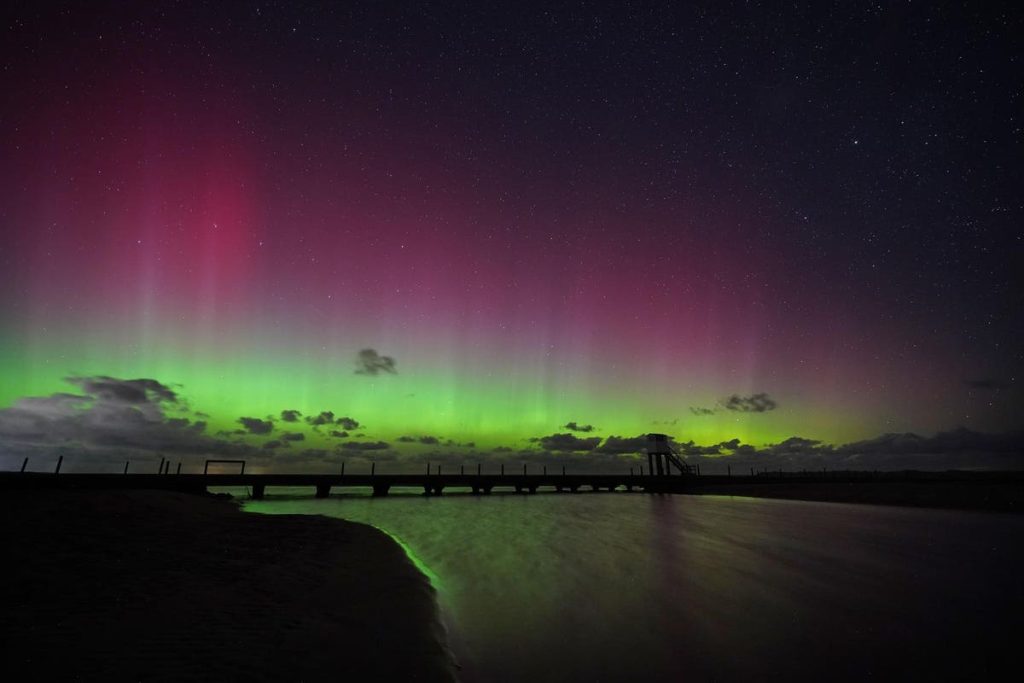Experts are predicting northern lights to be visible from U.S. states as far south as Colorado and Missouri on Tuesday.
A notable geomagnetic storm is expected to result from the arrival of a coronal mass ejection that erupted from the surface of the sun on Saturday, Sept. 16 and was aimed in the direction of Earth.
It’s expected to arrive on Tuesday, Sept. 19, though exactly when isn’t clear. The National Oceanic and Atmospheric Administration’s Space Weather Prediction Center’s 3-Day Forecast is predicting G1 (Minor) to G2 (Moderate)-class geomagnetic storms to peak between 06:00 and 09:00 UTC (02:00-05:00 EDT, 01:00-04:00 CDT, 00:00-03:00 MDT and 23:00-02:00 PDT) on Sept. 19. The NASA model is predicting later on Sept. 19, according to SpaceWeather.com on Sunday, which will mean during the day in North America.
Uncertain Timing
Although the timing is not certain—it never is—a G2-class storm can often mean impressive displays of northern lights. “During a similar G2 storm on Sept. 12, auroras were photographed in multiple U.S. states as far south as Colorado and Missouri,” according to SpaceWeather.com.
A CME is a cloud of magnetic fields and charged particles from the sun that streams into space at up to 1,900 miles (3,000 kilometers) per second. It can take a few days to arrive, if it’s directed at Earth, where it causes a geomagnetic storm often resulting in displays of aurora.
Experts Sound The Alarm
“Eruption of a huge filament, right in the Earth strike zone!” tweeted Dr. Ryan French, a solar physicist at the National Solar Observatory (NSO) in Boulder, Colorado and the author of The Sun: Beginner’s Guide To Our Local Star. “This filament will likely arrive at Earth in a few days time, hopefully producing a great aurora show!”
“Direct Hit! A snake-like filament launches a solar storm and it is Earth-directed,:” tweeted solar physicist Dr. Tamitha Skov. “Aurora possible to mid-latitudes.”
Geomagnetic activity is known to increase around the equinoxes in late-September and late-March when the position of the Earth’s axis relative to the Sun puts it side-on to the solar wind.
How To See The Northern Lights
It may sound obvious, but the view of the northern lights is typically better the farther north you are. “Being in the north will always give you an advantage, even if they are exploding and visible much farther south—you’ll just see them in the southern sky rather than in the northern sky,” said Tom Kerss, astronomer and author of The Northern Lights: The Definitive Guide to Auroras, in an interview.
However, what usually prevents the northern lights being visible even when they’re present is light pollution. “When the Northern Lights are low on the northern horizon they’re just so much harder to discern,” said Kerss. “It’s harder to determine what is the afterglow of the sunset versus the light pollution of a local town versus the faint glow of the aurora.”
Aurora has a kind of self-luminous character to it that is obvious once you know what to look for, but tricky for beginners to easily recognize. So it’s best to keep your expectations low. For best results, head somewhere with as little light pollution as possible (Light Pollution Map is useful).
“Sightings in the northern states of the U.S. are becoming more frequent, but the really dramatic sightings—the ones that people dream about seeing—are still had from Arctic locations,” said Kerss. So the best plan is to head to the Arctic Circle in Alaska, northern Canada or northern Scandinavia (Norway, Finland, Sweden and Iceland), where more frequent and brighter displays aremore likely.
Wherever you try for a view of the aurora, you need five things—clear skies, dark skies, warm clothes, low expectations and bags of patience. A manual camera on a tripod capable of taking long exposures helps, too.
Wishing you clear skies and wide eyes.
Read the full article here










